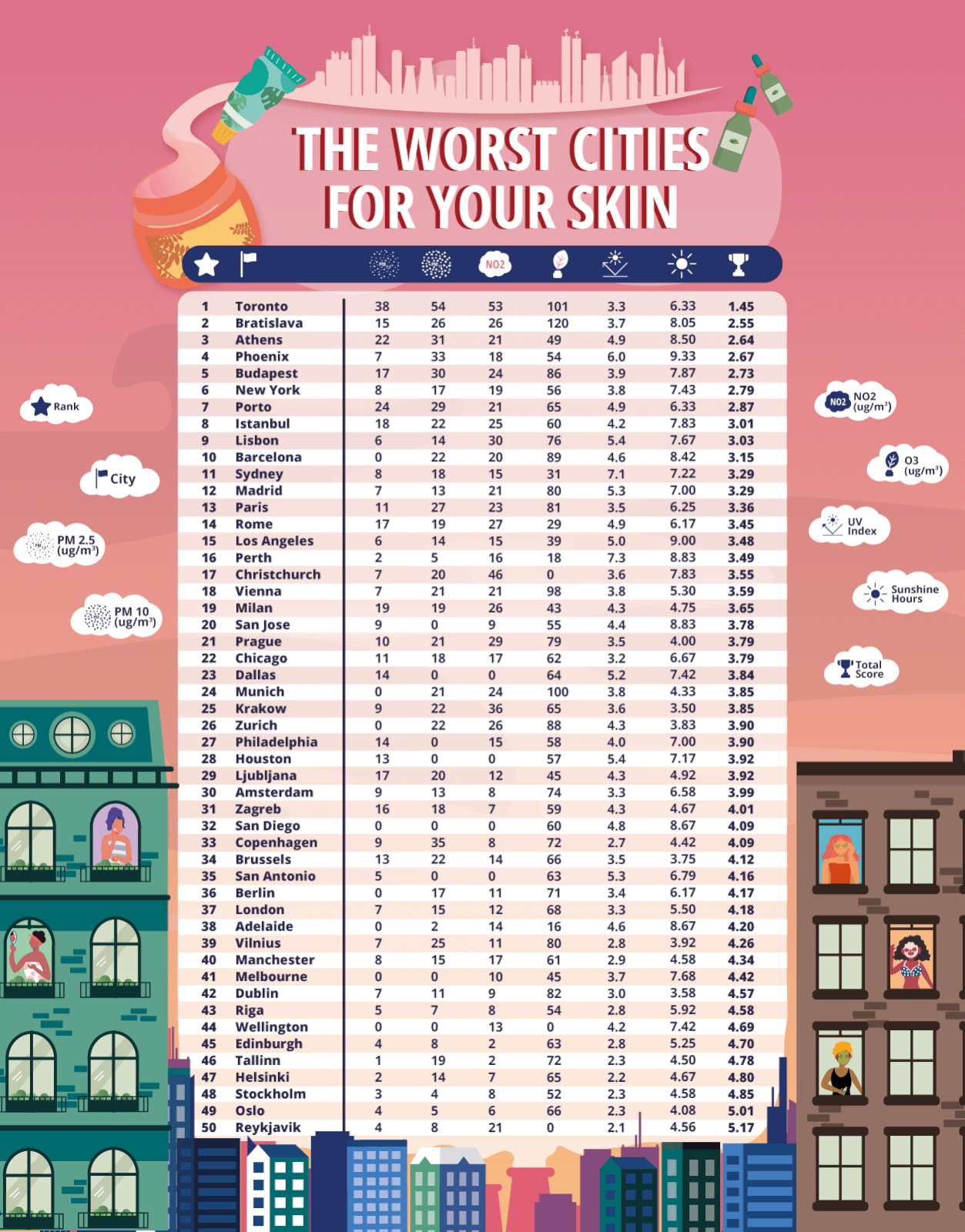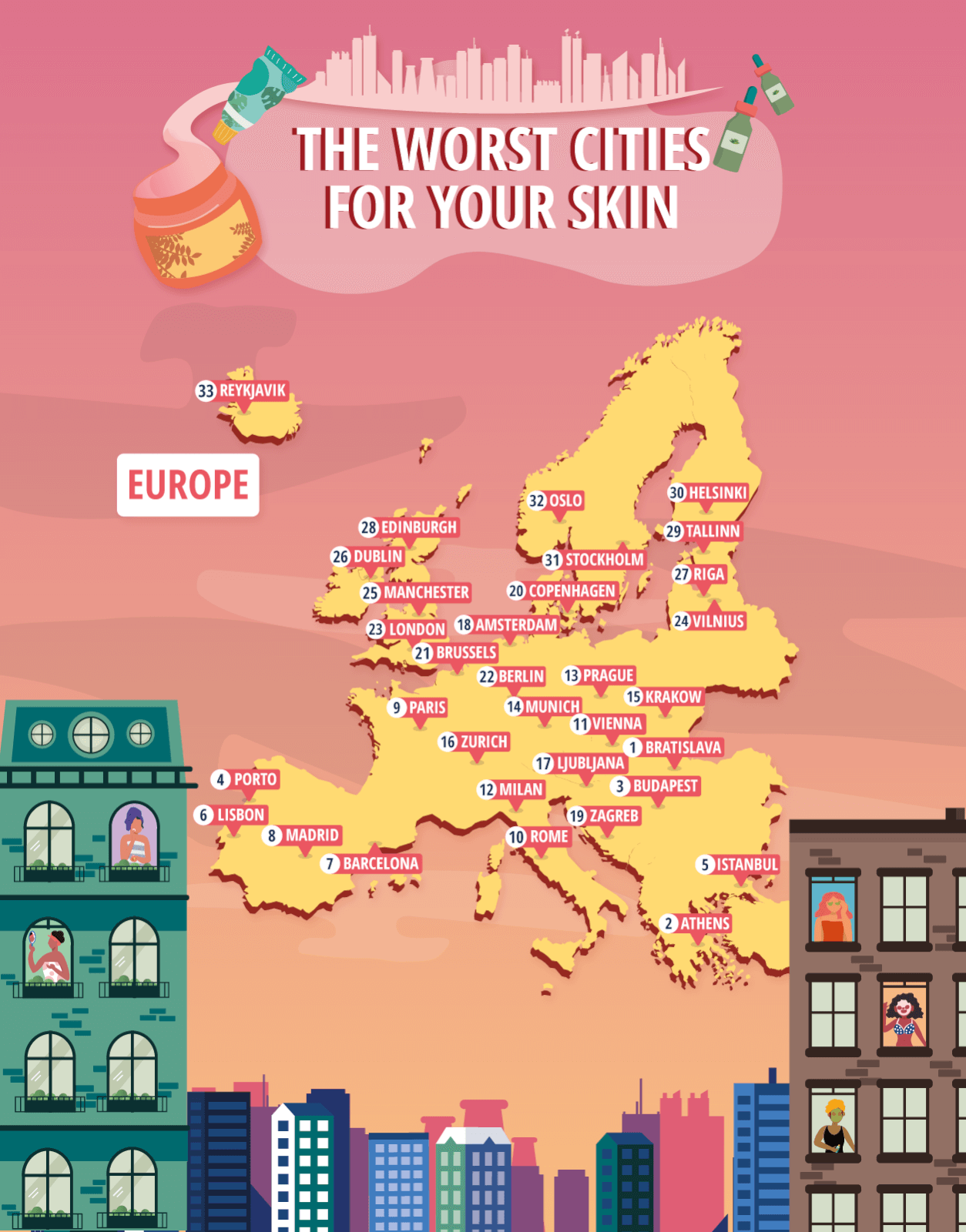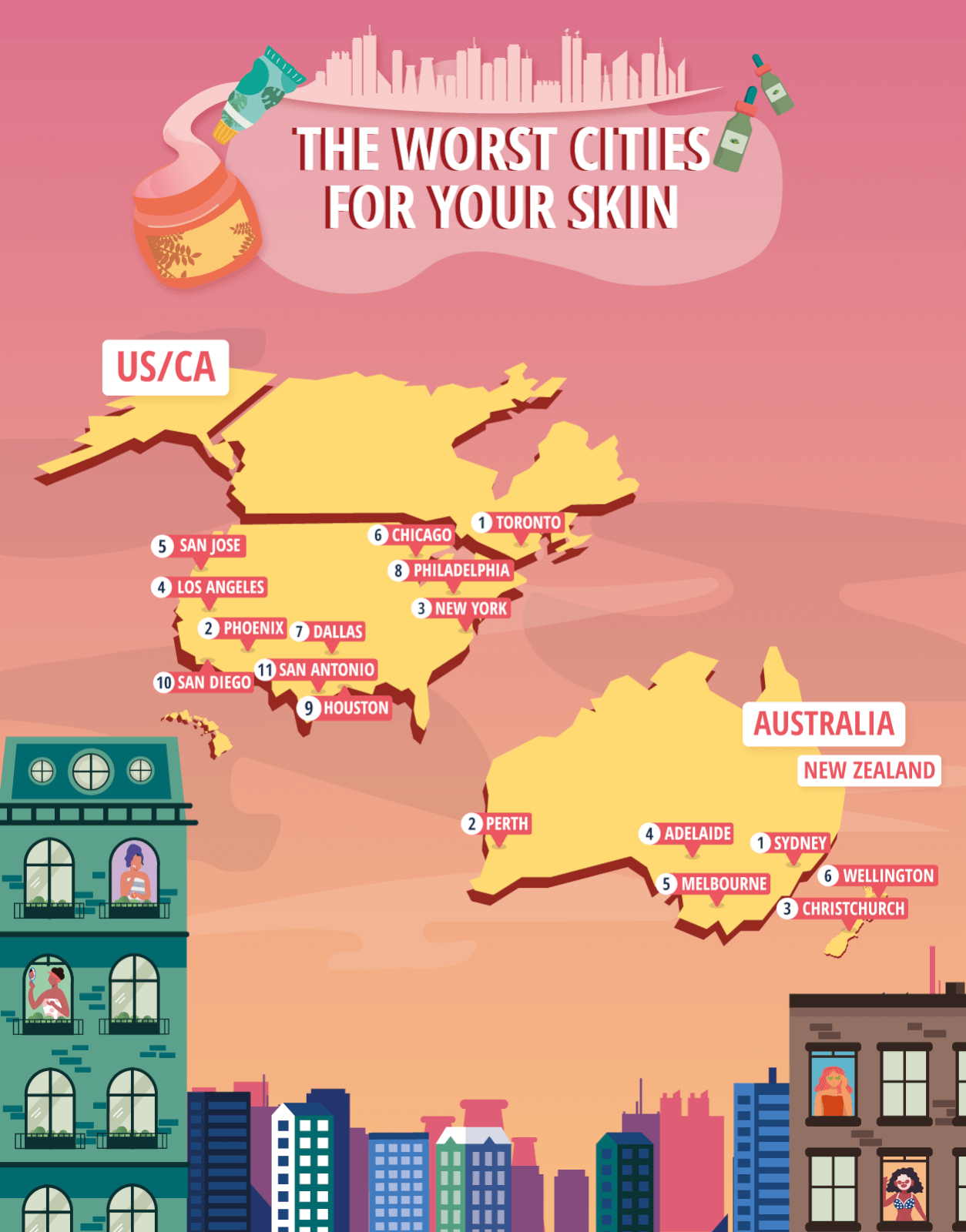The Burrow

Skincare and anti-ageing have always been hot topics. According to Statista, the total expected revenue worldwide for the skincare industry stands at a staggering US$155.7billion in 2023, and is expected to increase by 3.91% every year; with the USA, Japan, and China spending the most.1
Whilst ageing, hormonal changes, and health conditions can all impact your skin, a lot of the preventable damage is caused by UV rays from the sun, so stocking up on moisturisers just isn’t going to cut it.
If you’ve noticed fine lines appearing on your face, or you’re finding your skin has really dried out, then it could be down to the environmental factors of where you live.
To uncover which cities in the world are the best for your skin (and which are the most harmful), the health insurance extras cover experts at Compare the Market have crunched the data, looking at a variety of factors, from the levels of harmful pollutants in the air, through to UV levels and hours of sunshine. So, read on to see if you live in a city where you need to take extra precautions with your skin.

We looked at 50 cities globally, to see which parts of the world are the worst for your skin, as well as breaking the results down by continents.
We found that two of the five worst cities are situated in North America. Toronto is officially the worst, with Phoenix the fourth worst, New York not too far behind as the sixth worst.
Toronto is let down by the harmful particles found in the air, based on several different Particulate Matter (PM) and other measurements. It has the most PM 2.5, PM 10, and NO2 of all cities on the list, and the second most O3, behind Bratislava.
Phoenix’s UV levels and hours of sunshine don’t help it, due to its location in the Sonoran Desert – in fact, at 9.33 hours of sunshine on an average day, it has the highest sunshine levels of all 50 cities we analysed, with Los Angeles not far behind, at 9.00
The UV index is a great indicator of determining how strong the sun is, and the risk of not just sunburn, but permanent damage to your skin. According to Cancer Research, a score of between 3 and 5 on the index means you’ll have moderate exposure, and anything over 6 is classed as high risk.2
Bratislava, Athens and Budapest are three European cities in the top five, but if we extend it out to the top 10 worst cities, then more European destinations make the cut, including Porto, Istanbul, Lisbon and Barcelona.
Sydney comes in 11th position, which is the worst in Australia and New Zealand, again, due to the air particles. it has the most PM 2.5 across these two countries, and it has the second highest score on the UV index globally, at 7.08 (Perth came top, at 7.33).
If we look at the other end of the spectrum on a global scale, most of the best countries for your skin are based in Europe.
Scandinavia storms the leader board, with four of the top five cities all situated in the Nordics. Iceland’s capital, Reykjavik, comes in first place, with the lowest UV index score on the list at 2.08, as well as the lowest levels of O3 in Europe (and joint top with several New Zealand cities).
Oslo comes in second place, Stockholm in third, and Helsinki in fourth. Whilst sunshine can help to lift our moods, stepping out without sunscreen can be extremely damaging, so the lower levels of sunshine in these cities help to protect your skin.
The dark winters of the north offset endless nights of summer sun. This means in Oslo, you can expect to have around 4.08 hours of sunshine a day (the seventh lowest in Europe), and 4.58 hours in Stockholm, helping to protect your skin. Scandinavian cities also have the lowest scores on the UV index.
Two Baltic capitals also make it into the top 10, with Tallinn in fifth place and Riga in eighth. Filling in the top best countries was Scotland’s capital, Edinburgh, which came in sixth place. Dublin came in ninth, and Melbourne in 10th.
As for other factors, the European capitals with the lowest levels of PM 2.5 were Berlin, Barcelona, Munich, and Zurich at 0; and Tallinn, Edinburgh, and Oslo have the lowest levels of NO2. When it comes to sunshine hours, whilst Scandinavian capitals are low, they’re not the lowest. Krakow has the least number of average daily hours, at 3.5, with Dublin, Brussels, Zurich, and Vilnius all also seeing less than four hours of sunshine on a typical day.

Moving over to North America, all top five cities are based in the USA, with Texas’ San Antonio in top position, despite placing 16th overall, globally. San Diego comes in second place, Houston in third, Philadelphia in fourth, and Dallas in fifth for America and Canada.
Looking at the harmful air particles and gas, San Diego scores particularly well, with no PM 2.5, PM 10, or NO2 in the air – although it does have some of the highest levels of sunshine, at around 8.66 hours a day.
In fact, several US cities don’t have any PM 10 or NO2 in the air – Dallas, San Antonio, and Houston all have neither of them.
Out of the six cities in Australia and New Zealand we looked at, Wellington scored the best for skin, followed by Melbourne and Adelaide. Neither Wellington or Melbourne have any PM 2.5 or PM 10 particles in the air, and Adelaide doesn’t have any PM 2.5.
Melbourne also has the second lowest UV index levels in Australia and New Zealand at 3.67 (Christchurch came first), and Wellington also had the second lowest levels of sunshine between the Tasman Sea nations at 7.41 hours a day (Sydney just made it into first place, at 7.21).

If you’ve noticed your fine lines and wrinkles have become more prominent, then it could be the result of photoaging, which is where your skin ages due to UV radiation exposure caused by the sun.
Unlike chronological skin ageing, which is natural and non-preventable, this is. Here are a few things you can do to reduce the signs of ageing on your skin.
Are you guilty of only applying sunscreen when the sun’s shining? Then ultimately, you’re prematurely ageing your skin. UVA and UVB rays are still present when it’s cloudy, so make sure you put SPF 50 on your face and neck every day, to protect yourself.
Even if your moisturiser or foundation says it has SPF in it, the levels likely won’t be enough, which is why it’s important to add this step to your daily skincare routine.
Whilst photodamage to your skin can’t be completely reversed, there are ways you can minimise the damage. Retinol is one way, and it typically comes as a serum or in your moisturiser.
Retinol will help to reduce your fine lines and wrinkles, as well as encourage collagen to grow, which will leave your skin feeling firmer.
Adding Vitamin C to your diet can also help your skin’s health. Because it’s an antioxidant, it can help to protect your skin against the negative effects of environmental factors, such as pollution and UV rays. It also helps make your skin look brighter and feel plumper, thanks to it encouraging collagen growth.
You can take Vitamin C in a variety of ways, including as tablets, gummies, and powders; or you can incorporate them into your skincare routine with creams, exfoliators, and serums.
Head of Health Insurance at Compare the Market AU, Lana Hambilton, states “As we age, it’s normal for us to want to retain a youthful complexion, and we often wouldn’t think twice about paying for an expensive branded serum or moisturiser, if we think it will help.
“A lot of us might overlook or become complacent with the environmental factors that play a huge part in our skin’s health. We should protect our skin every day,” says Ms Hambilton.
”Protecting our skin isn’t just about looking younger – it’s about our health. Excessive sun damage could lead to skin cancer, which could unfortunately spread to other parts of your body.
“The good news is that by taking precautions, you can reduce this risk; some health insurance funds will pay a benefit towards skin checks or Cancer Council UV protection products, helping you take a proactive approach towards your skin care,” Ms Hambilton continues.
“Furthermore, the right level of hospital cover can be beneficial should you develop skin cancer, as it can help pay towards private inpatient treatment, offering you more choice of where and from who you receive treatment as well as allowing you to avoid the public waiting list,” says Hambilton.
This dataset ranks 50 cities across Europe, North America, and Australia, based on how good they are for your skin. To do this, 6 different factors were used. Once the factors were collected, they were then normalised, to provide each factor with a score of between 0 and 1. The normalised values were then summed, to give each city a total score out of 6. The cities were then ranked from highest to lowest, based on their total scores. The factors used are as follows:
All factors were indexed so that a high value received a low score.
Data gathered is correct as of 06/06/2023. The most recent data possible was used in compiling this dataset.